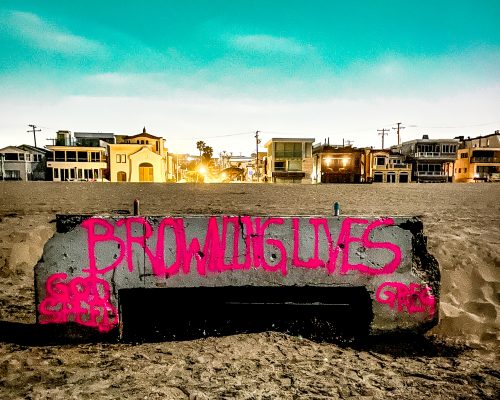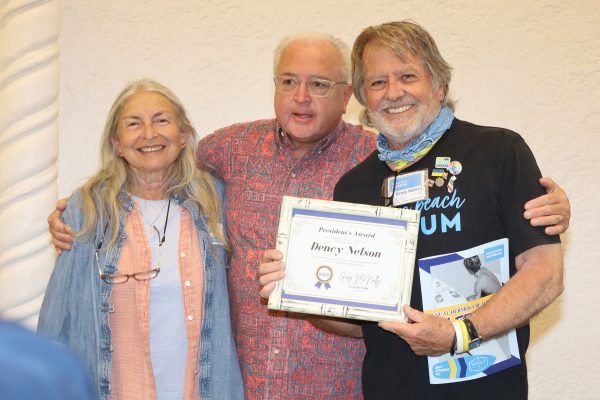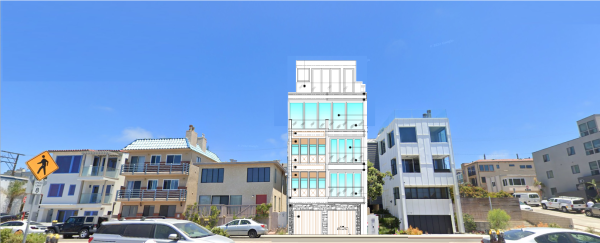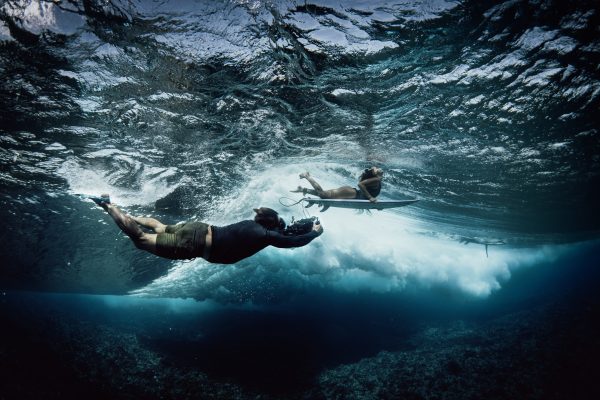Is a desalination plant part of the answer to the South Bay’s looming water crisis?

It might be difficult to tell from the sprinklers and manicured grass, but Southern California is running out of water.
The state’s latest drought designation was officially lifted last year, yet according to many experts, if development continues at its present pace and people keep using about the same amount of water, Southern California could face skyrocketing water rates within 10 to 20 years.
The problem is that Southern California, and the South Bay in particular, is largely dependent on imported water. In Manhattan, Hermosa and Redondo as much as 80 percent of the water that rinses your shampoo out in the morning and washes the dishes and clothes originates hundreds of miles away.
A 400-mile aqueduct carries water each day over mountains and across valleys from the San Joaquin Basin near Sacramento, as does another pipeline from Lake Mead on the Colorado River southeast of Las Vegas. Most of it goes to agriculture and the growing needs of urban Southern California. The sources of that water, however, are drying up due to global warming. And when water levels get too low, court orders limit imports to protect endangered species such as salmon and Delta smelt.
Water experts predict that California could soon face its greatest water challenge yet. The question is whether state and local leaders will impose strict conservation measures or turn to the more costly, energy-intensive method of producing freshwater through seawater desalination – or, possibly, some combination of the two approaches.
“We’re looking at desalination because of some major changes to the water system, such as the bay delta and the ability of judges to interrupt the water flows,” said Ron Wildermuth, manager of West Basin Municipal Water District’s public information and conservation. “There’s climate change, more evaporation, longer droughts, heavier rain that goes to the ocean. The Colorado River is going to be a drier river. If we weren’t examining local alternatives, we wouldn’t be doing our job.”
The public agency, governed by a five-member board of directors, controls a $166 million annual budget and distributes water wholesale to 17 cities in the South Bay and unincorporated areas of Los Angeles County. West Basin would also be the chief sponsor of a local desalination plant.
Wildermuth said the district is doing everything it can to encourage reductions and maximize recycling before turning to desalination. Today, around two-thirds of Los Angeles area tap water, on average, is used outdoors (In the South Bay it’s around 20 percent only because lawns are smaller).
In California, the fight over water is legendary, from the Gold Rush to Los Angeles in the 1970s. In many ways, the stakes have just been raised.
From San Diego to Marin, about a dozen ocean desalting projects costing hundreds of millions of dollars each are in the works. Four are slated to break ground within the next several years, possibly including one in the South Bay in either Redondo or El Segundo.
A proposed plant here would likely draw in about 40 million gallons of seawater daily and produce around 20 million gallons of freshwater. That would account for about 10 percent of the region’s projected water needs by 2020. The cost of such a plant would likely be about $400 million.
When it comes to preparation, West Basin has spent more time and money on planning a desalination plant than any other water agency in California. The board has approved at least $18 million for two pilot projects over the past 10 years, one in El Segundo and the other in Redondo Beach.
Environmental groups have opposed ocean desalination in general for decades, painting it as a costly alternative that misdirects funds from conservation. They also point to desalination’s heavy carbon footprint and its possible harmful effects to marine that become entrapped in water intake pipes. Those concerns have lessoned as desalination technology has improved, which is partly the function of pilot projects. But the concern over the amount electrical energy required to operate a desalination plant has grown.
“This board wants to be responsible,” said Rich Nagel, West Basin district general manager. “Are we going to 100 percent mitigate every environmental impact? I don’t know if that’s possible. But we’re going to do a good job at trying.”
Legal challenges have dragged the permitting out for more than a decade on similar, proposed plants in Carlsbad and Huntington Beach. The possibility of desalination coming to Redondo has already sparked heated criticism from Redondo Beach City Councilman Bill Brand.
“We ought to be tapping into conservation much more than we are,” Brand said. “We shouldn’t feed our wasteful ways with a new desalination plant.”
Plying the waters

Tucked behind the northeast corner of King Harbor Marina, next to the Sea Lab Aquarium in Redondo Beach, a $10 million experiment is taking place over how best to turn the salt water of the Pacific Ocean into drinkable tap water.
District leaders say they need this second pilot project, despite a smaller version in El Segundo that cost around $8 million, because desalination plants are extremely site specific and they could possibly build one at either of the two locations. The Redondo plant, which began operating earlier this year, is expected to run until January 2013 with the potential for another two years if there’s still value, say district engineers.
“Our goal would be to walk away from this demonstration period having a foundational approach to how we’d operate a full-scale facility,” says Phil Laurie, principal engineer, who joined a group of West Basin officials on a recent media tour.
Conservationists argue that desalination is too energy intensive. Removing salt from seawater requires about 3,400 kilowatt-hours per acre-foot of freshwater produced, based on a study by University of California at Santa Barbara researchers.
Modern desalination plants use reverse osmosis, rather than distillation, which involves boiling the water and later condensing the steam. Most of the energy during reverse osmosis goes toward putting water under 800 pounds per square inches of pressure and pushing it through membranes. The membranes are wrapped like a roll of carpet and placed in a cylinder. Each plant requires multiple membranes. More than half the water goes around each membrane, redirecting unwanted material while the rest continues through to the final stages of treatment.
A tour through the Redondo Beach pilot project, offered to the public three times a day, gives visitors a picture of the various ways West Basin engineers, and lead contractor United Water, are testing to mitigate desalination’s main drawbacks.
An educational exhibit covers water conservation with facts such as the average 10-minute shower uses about 40 gallons of water. There’s an explanation for the looming water shortage and the need for desalination. It features a new type of seawater intake screen that protects marine life where water is drawn out of the sea.
In order to reduce imported water demand by 2020 – part of California’s overall water plan – West Basin expects to bring water imports down by 10 percent with desalination. At the same time, they want to double sewer water recycling from 40 million gallons per day to 70 million through a program that’s gained national recognition.
Residents too would be expected to reduce consumption by about 20 percent. All of it together would reduce the district’s dependence on imported water from 66 percent today down to 33 percent by 2020, Laurie said.
Desalination opponents want to see water use drop even further through conservation. The district has already reduced consumer use by about 15 percent over the past year. But today, overall per person water use is still somewhat high. In Redondo and Hermosa, residents currently use about 116 gallons of water per day. In Australia, desalination opponents argue, water use was brought down to around 60 gallons per person before turning to desalination.
“It may be a bit ambitious to think people will just shut off their water,” said Bob Muir, spokesman for the Metropolitan Water District of Southern California, which distributes imported water to regional water agencies.
As part of an incentive program, Metro is offering water agencies $250 per acre-foot toward water they get from desalination. The incentive represents a taxpayer subsidy for burgeoning projects. Muir says the agency hasn’t lost sight of conservation, but that it’s about tapped out.
“Since 2000, we’ve really encouraged people to make wise choices when it comes to their landscaping because it can make a difference,” Muir said.
Trade-offs
Desalination’s benefits would allow the region to import less water, which comes with its own energy and environmental costs. It takes about 3,100 kilowatt hours of electricity to pump water from the Delta compared to around 3,400 for desalination.
Tom Rooney, president and CEO of Energy Recovery Inc., said he sells a device that makes desalination competitive. The technology captures and reuses up to 98 percent of the energy that would otherwise be wasted from putting water under intense pressure.
“It makes the entire desalination process 60 percent more efficient,” Rooney says. “Our devices have contributed heavily to making the carbon footprint of the plant more workable and also making the economics work.”
Companies trying to sell desalination to public officials claim to be able to produce water for around $1,000 per acre-foot, an amount equal to the average cost of imported water today. But most accounts put the cost of desalination, based on energy prices in the United States, at more than $3,000 per acre-foot. West Basin officials district believe they can produce desalinated water for between $1,200 and $1,600 per acre-foot.
Locally, West Basin officials say desalination will directly offset the amount of water the district imports. But projections indicate overall imports to Southern California will not diminish, because ongoing demand exists from agriculture and other inland communities, according to Muir.
“I don’t think it’s ever been explained as a way to decrease the use of imported water. It’s really to provide more water reliability for the region,” Muir said. “Every drop of water desalinated will free up the like amount of water for other uses.”
Others see desalination as an emergency measure. If, for instance, the levies holding back the San Joaquin Basin were to burst because of an earthquake, which some analysts predict, Southern California could be without a large part of its water supply.
“Conservation is not the same as water supply,” said Redondo Beach City Councilman Steve Diels. “It does appear that we are going to need additional supplies in the future. And we can’t rely on Northern California.”
A South Bay plant

The push for desalination ebbs and flows in California with the ongoing cycles of drought and abundance. Santa Barbara built an ocean desalination plant in the 1990s during a drought. Now it sits idle, too costly to operate. Another plant in Catalina is reserved strictly for emergencies. The City of Los Angeles relieved its water woes through strict conservation measures. And discussions in Long Beach to build a plant have largely subsided.
Plans to bring desalination to the South Bay have been percolating among West Basin officials for more than a decade. Unlike privately-owned ventures in Carlsbad and Huntington Beach, West Basin officials say they want to maintain public ownership.
Carol Kwan, the West Basin board member representing the South Bay beach cities, is a staunch supporter of desalination. She said the district is exploring building a full-scale plant at this point, but nothing has been approved so far.
“Because it’s so controversial we can’t even publicly say much about it,” Kwan says. “It’s no sure thing at all.”
Kwan, who has served on the West Basin board for more than a decade, has shared time on the board of the American Membrane Technology Association and the New Water Supply Coalition – both pro-desalination trade groups – as well as CalDesal, a pro-desalination lobbying group funded by California water agencies. She also took a trip to Australia to visit desalination plants there.
Critics of desalination feel board members receive a one-sided perspective from the various trade groups and industry representatives at conferences such as the annual California Water Association meeting.
“Sometimes they lobby pretty hard,” Kwan says. “You have a few private firms that would like to see if a public entity would like to privatize. With all due respect you listen to them.”
Conner Everts, who heads the non-profit Desal Response Group, would rather see the district resist desalination at all cost. He said it detracts from conservation efforts.
“They haven’t paid attention to some of the other stuff because they have redirected money to desalination,” Everts said.
A plant in El Segundo or Redondo would likely share the existing surface water in-take pipes used by the power plants there now. It’s these same pipes the state of California is in the process of outlawing in coming years when it comes to power plants.
“That just exacerbates the problem in our mind,” said Joe Geever, a spokesman for Surfrider Foundation, which has opposed multiple desalination plants in courts over the past 10 years. “If you’re going to protect marine life, you have to protect it from all of these industrial intakes.”
As part of the demonstration project in Redondo, engineers are experimenting with a new wedge-wire screen to minimize harm at the ends of those pipes. So far, the technology is working, according to West Basin officials.
By 2025, AES hopes to decommission the existing power plant and build a newer, more efficient plant with a smaller footprint and without ocean cooling water at the same location, said Eric Pendergraft, president of AES Southland.
“We’re going to have property available open to all types of uses including desalination if it’s supported by the city and the local community,” Pendergraft said.
The energy company is currently leasing space adjacent to its Huntington Beach generator for another proposed desalination plant that would also use the water intake pipes targeted by the state. He acknowledged the existing pipes currently result in the loss of some marine life, but says it’s negligible.
“The operation of those ocean water cooling certainly results in the mortality of marine life, but it does not in our view change the productivity of the overall marine environment,” Pendergraft said.
Any talk of a new industrial plant in Redondo also brings up the heated debate over development around the AES plant.
“I’m mainly opposed to the re-industrialization of the Redondo Beach waterfront,” says Brand, who is leading a citizen’s initiative to shut down the power plant and build a park. “A desalination plant is more industrialization of our waterfront and an inappropriate use of what’s there now.”
Are we conserving enough?
Water experts say California can’t conserve its way out of an impending water crisis. A landmark Scripps Institute study in 2008 said Lake Mead had a 50 percent chance of going dry by 2021. But conservationists argue it’s a manufactured crisis, created by the industries that stand to benefit from desalination.
“We don’t have a water crisis we just mismanage the water we have,” Everts says.
A Pacific Institute report, Waste Not, Want Not, said California’s water needs could be met in the foreseeable future by eliminating waste. Debbie Cook, a former Huntington Beach City councilwoman, believes water agencies could drive greater conservation with more drastic pricing.
“Every year they sell this idea that we are in a drought,” Cook says. “Let’s start to learn to live with the normal weather patterns of Southern California. If we had a drought we would price water appropriately, which we don’t.”
Due to record rainfall last year Southern California will have more water in storage than it has ever had as a region, says Muir, spokesman for Metro. But that doesn’t change the need for desalination, he says.
“We really have an obligation in Southern California to develop any and all of our resources,” Muir says. “Whether it be desalination, continuing to recycle supplies, conserve supplies or manage efficiency. It’s not an either or proposition. We can’t invest in one alternative. We need a series of alternatives to maintain reliability in the coming decades.”
West Basin officials insist they’re doing as much conservation and recycling as they possibly can.
“It’s not like we’re looking at the ocean to solve all our future water problems,” says Phil Laurie, principal engineer. “The mainstay of our expansion will be conservation and recycling,”
The district currently produces five types of potable water from recycled sewer water, a process similar to desalination yet requiring roughly a quarter of the energy.
Stacking up
Manhattan and Hermosa are among cities to have passed conservation ordinances in recent years, while Redondo relies mostly on voluntary compliance and tiered water pricing.
A recent Sierra Club report gave Redondo Beach a “poor” rating for the number of mandatory water conservation measures out of cities in Los Angeles and Orange counties. Manhattan and Hermosa Beach ranked “good.”
Redondo and Hermosa residents reduced water consumption from an average of 141 gallons per-person-per-day in 1995 to 2004 to around 116 gallons in 2010, said Ken Jenkins, conservation manager for California Water Service Company, which serves both cities.
In order to encourage conservation, the water company offers subsidies for low-flow nozzles and other water saving devices, but it’s up to cities to enforce reductions if they so choose, he said.
“We’re interested in working with all our cities to identify ways that make sense to that community to reduce water use,” Jenkins said. “Desalination would be one more water supply option that can be drawn upon if needed. It’s important to keep all these water supply options in context and how they interact with one another.”
In July 2009, Manhattan restricted outdoor irrigation during the day and within 24 hours of any rainfall. Those measures were lifted when the state drought order was repealed, but it’s still having an impact on consumers, said Raul Saenz, utilities director.
Over the past two years, Manhattan residents lowered their water consumption by 16 percent, said Saenz, who credits the success largely to an education campaign by LA Department of Water and Power. Even before the city instituted the water restrictions, people reduced consumption by about 20 percent, he said.
“I was so incredulous of the numbers even though I had witnessed them begin to diminish, I sent people back into the field to have our meters calibrated to be absolutely sure we were seeing what we were seeing,” Saenz said.
In January 2010, Manhattan created tiered pricing, where it costs more when you use more, which pushed more reductions. After the drought was lifted earlier this year, the numbers rose a bit, yet they are still down 16 percent from 2008 levels, Saenz said.
“While the pocket book is important, in a community like Manhattan Beach if you address people with advertising and various incentives and you keep them informed, people will respond.” ER
EDITOR’S NOTE: This report is a collaboration of the Public Education Center’s DCBureau.org










